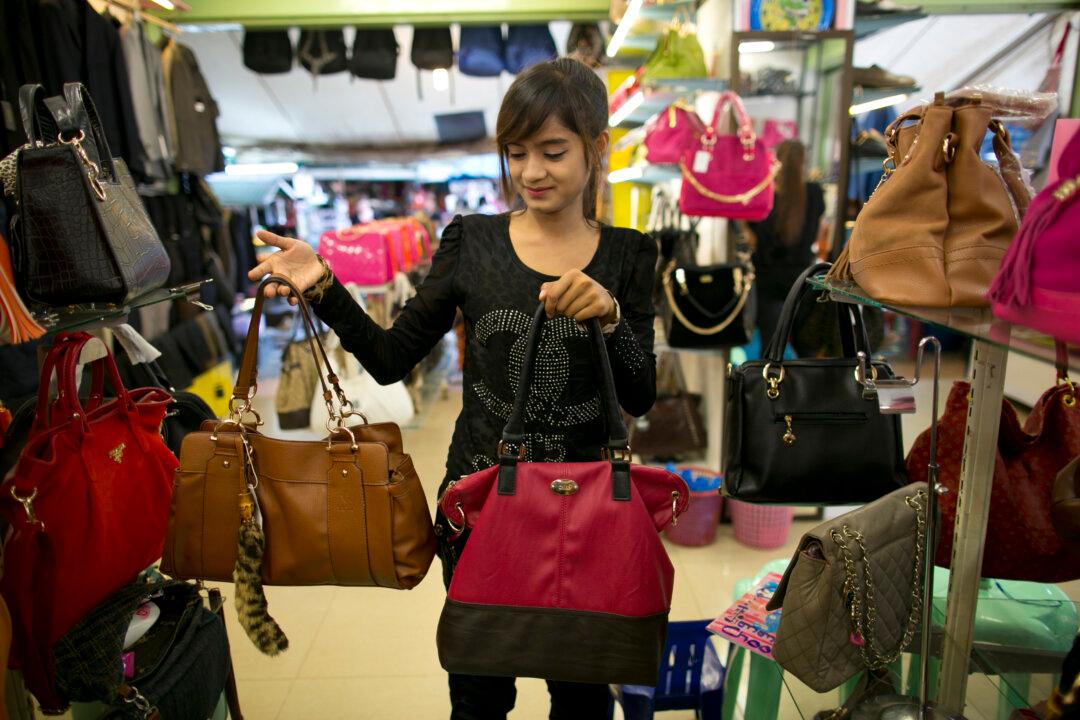The approach to solving the international crime of counterfeiting was, until recently, based around trying to negotiate with the main perpetrator: China.
But times have changed. Among the impacts of documents leaked by former NSA contractor Edward Snowden—which expose the NSA’s international spying—was the end of any possible discussion with China on intellectual property theft for years to come.
Thus, the focus has shifted, and the United States and its allies are now looking to stop China’s IP theft and the subsequent flow of counterfeit goods through other means.
In New York City’s Times Square, on Jan. 14, a very visible example of this new approach was aired on the NASDAQ screen.
The public advertisement on the big screen shows child laborers and men with guns, while giving a brief introduction to the dark ties that bind the counterfeiting industry with organized crime.
Counterfeit goods and the theft of intellectual property go hand in hand. Criminals and nation-states looking to tap the markets of foreign businesses will steal product designs, and then begin manufacturing their own copies of the products.
Child Labor
The counterfeit industry “supports child labor, 7-year-olds chained to sewing machines, eating two meals of rice a day,” said Valerie Salembier, president of the Authentics Foundation, a nonprofit that advocates about the dangers of counterfeits.
Salembier was publisher of Harper’s Bazaar when it printed an investigative story on the counterfeit industry in January 2009. It included a view from inside a factory in Guangzhou, China, where two dozen children aged 8 to 14 were making knock-off designer bags on rusty sewing machines.
Salembier said that the public response to the article in Harpers Bazaar makes her believe public education can be a powerful tool against the counterfeit industry.
“These stories of young girls working in sweatshops in China, the response we got for that story was overwhelming,” she said.
(China) Cooperation Problems
While few could doubt that the UNODC campaign is a step in the right direction, it is reminiscent of problems raised when the Anti-Counterfeiting Trade Agreement (ACTA) was signed in October 2011 by the United States, Australia, Canada, Korea, Japan, New Zealand, Morocco, and Singapore.
Experts argued then—as they do now—that any significant effort to end counterfeiting requires broad cooperation from China. And Chinese authorities haven’t shown any serious interest in uprooting the counterfeit industry.
An estimated 15 to 20 percent of all products made in China are counterfeits, according to the MIT Center for International Studies. The Penn State Journal of Law & International Affairs also reported in 2012 that close to 80 percent of counterfeit goods seized at U.S. borders come from China.
Asking Chinese authorities to stop the flow of counterfeits is “impossible, especially since eight percent of China’s GDP is based on counterfeit goods,” said Daniel Katz, an expert on the effects of outsourcing manufacturing, in a telephone interview. “A huge amount of their own revenue comes from that, so how can they just get rid of that revenue? What are they going to replace it with?”
“It’s a situation that can’t be cracked down on until China changes as a country,” Katz said.
‘Ask the Consumer’
The public awareness campaign, Counterfeit: Don’t buy into organized crime, is being run by the United Nations Office on Drugs and Crimes (UNODC). Of course, China is a member of the UNODC, but the campaign makes no mention of China. The focus is solely on transnational organized crime with groups such as the Chinese Triads, Italian Mafia, and Japanese Yakuza on the list.
“The aim of the campaign is to ask the consumer to look behind the purchases they make, particularly if they knowingly buy counterfeit products, and make an ethically informed choice about their purchases,” said Alun Jones, UNODC chief of communication and advocacy division for policy analysis and public affairs, in an email.
Jones said the campaign is part of a larger initiative from the UNODC that started mid-2012 to raise awareness about organized crime and the United Nation’s efforts against it.
And the scope of the problem can’t be understated. Jones said the global trade in counterfeits brings in $250 billion a year, “and is most probably the second largest earner for organized criminal groups after drug trafficking.”
Stopping the Flow
Flashback to May 2013. For the first time, the Pentagon called out China directly for its cyberattacks aimed at stealing U.S. corporate intelligence. This came just a month after Microsoft won a high-profile case in Beijing Higher Court on a lawsuit against China’s owner and manager of Bai Nao Hui, over the spread of counterfeit copies of Windows in China.
Also in May 2013, Jon Huntsman Jr., the former U.S. ambassador to China and now co-chair of the private Commission on the Theft of American Intellectual Property, said, according to New York Times, “China is two-thirds of the intellectual property theft problem, and we are at a point where it is robbing us of innovation to bolster their own industry, at a cost of millions of jobs.”
For China’s communist leadership—which broadly censors the Internet and tightly controls the country’s media—public image matters. And it was precisely its public image that was being tarnished by the exposure of its campaigns of spying and theft.
The administration’s attempt to have the discussion with the Chinese leadership was derailed by Snowden’s leaks of the NSA’s spying, however. Even though the NSA targets foreign intelligence, rather than business secrets, the Chinese used the revelations to accuse the United States of hypocrisy.
Given that dialogue is no longer in the cards, other proposals have been made to deal with Chinese counterfeit goods and intellectual property theft.
Many were outlined in the U.S.–China Economic and Security Review Commission’s 2013 report to Congress. They include banning imports from Chinese companies that counterfeit U.S. goods, preventing offending Chinese companies from using U.S. banks, and establishing stronger systems for U.S. companies to file international lawsuits.
But the problem with any solution is that counterfeiting is built into the workings of China’s communist leadership, according to Greg Autry, senior economist with the American Jobs Alliance, and co-author of “Death by China.”
“They don’t really view, as individuals, that intellectual property theft is a problem,” Autry said in a telephone interview. “Under the communist ideology, of course, they believe that everything is communal.”
“In the communist system, it requires that you have to kowtow to the authorities in Beijing,” he said. “It’s a political decision that moves you forward. Having great ideas isn’t what gets you forward—stealing other people’s great ideas and helping the leaders profit is what gets you forward.”





